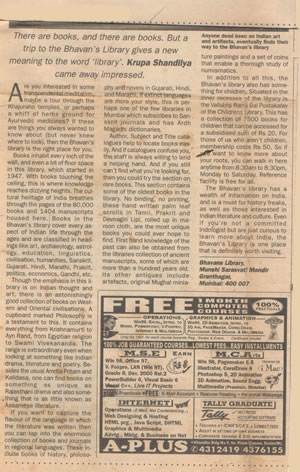
My Account | Online Catalogue | Contact Us
Munshi Saraswati Mandir Granthagar
(THE BHAVAN'S LIBRARY)
Media Reports
Articles
Trip to the Bhavan's Library

Newspaper: Times of India: Education Times
Date: May 31, 1999
There are books, and there are books. But a trip to the Bhavan 's Library gives a new meaning to the word 'library'. Krupa Shandilya came away impressed.
Are you interested in some transcendental meditation. Maybe a tour through the Khajuraho temples, or perhaps a whiff of herbs ground for Ayurvedic medicines? If these are things you always wanted to know about (but never knew where to look), then the Bhavan's library is the right place for you.
Books inhabit every inch of the wall, and even a bit of floor space in this library, which started in 1947. With books touching the ceiling, this is where knowledge reaches dizzying heights. The cultural heritage of India breathes through the pages of the 80,000 books and 1404 manuscripts housed here. Books in the Bhavan's library cover every aspect of Indian life through the ages and are classified in headings like art, archaeology, astrology, education, linguistics, civilisation, humanities, Sanskrit, Gujarati, Hindi, Marathi, Prakrit, politics, economics, Gandhi, etc.
Though the emphasis in this library is on Indian thought and art, there is an astonishingly good collection of books on Western and Oriental civilisations. A cupboard marked Philosophy is a testament to this. It contains everything from Krishnamurti to Ayn Rand, from Egyptian religion to Swami Vivekananda. The range is extraordinary even when looking at something like Indian
drama, literature and poetry. Besides the usual Amrita Pritam and Kalidasa, one can find books on something as unique as Rajasthani drama and also something that is as little known as Assamese literature.
If you want to capture the flavour of the language in which the literature was written then you can tap into the enormous collection of books and journals in regional languages. These include books of history, philosophy and novels in Gujarati, Hindi, and Marathi. If extinct languages are more your style, this is perhaps one of the few libraries in Mumbai which subscribes to Sanskrit journals and has Ardh Magadhi dictionaries.
Author, Subject and Title catalogues help to locate books easily. And if catalogues confuse you, the staff is always willing to lend a helping hand. And if you still can't find what you're looking for, then you could try the section on rare books. This section contains some of the oldest books in the library. No binding, no printing, these hand written palm leaf scrolls in Tamil, Prakrit and Devnagiri Lipi, rolled up in maroon cloth, are the most unique books you could ever hope to find. First hand knowledge of the past can also be obtained from the libraries collection of ancient manuscripts, some of which are more than a hundred years old. Its other antiques include artefacts, original Mughal miniature paintings and a set of coins that enable a thorough study of numismatics.
In addition to all this, the Bhavan's library also has something for children. Situated in the inner recesses of the library is the Vallabhji Ramji Bal Pustakalay or the Childrens Library. This has a collection of 7500 books for children that can be accessed for a subsidised sum of Rs 20. For those of us who aren't children, membership costs Rs 50. So if you want to know more about your roots, you can walk in here anytime from 8:30am to 8:30pm, Monday to Saturday. Reference facility is free for all.
The Bhavan's library has a wealth of information on India, and is a must for history freaks, as well as those interested in Indian literature and culture. Even if you're not a committed lndologist but are just curious to learn more about India, the Bhavan's library is one place that is definitely worth visiting.
Bhavans Library,
Munshi Sarasvati Mandir Granthagar,
Mumbal: 400 007
Anyone dead keen on Indian art and artifacts, eventually finds their way to the Bhavan's library